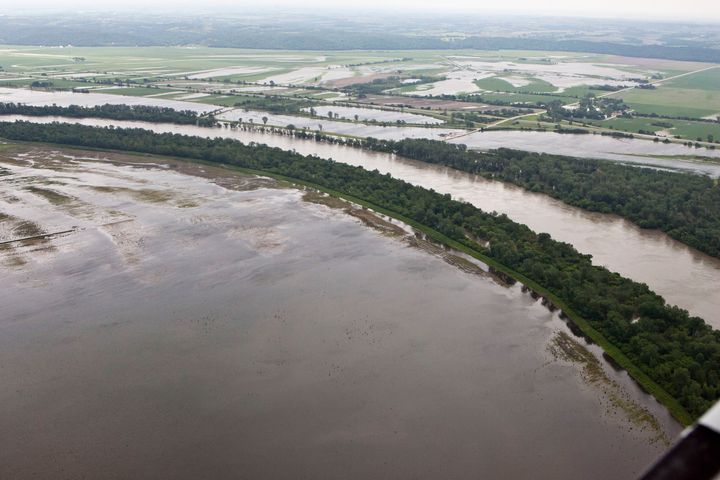
This year’s extreme weather, marked by unusually heavy precipitation in the northern half of the country and drought in the South and Southwest, continues.
The Missouri River is currently above flood stage in every state that it passes through. People are evacuating homes, bridges are down, and the Army Corps of Engineers is struggling to manage reservoirs swollen with runoff from weeks of heavy rains and melting mountain snowpack. A few unsettling pictures show floodwaters surrounding the Fort Calhoun Nuclear Generating Station, near Fort Calhoun, Nebraska (although the reactor is dry and, apparently, safe).
By comparison, due to the driest spring in Texas’ history, many of the state’s rivers have set record lows. In Lano, Texas, the town’s sole source of water, the spring-fed Lano River, is expected to soon run dry. Even recreation has suffered: rivers that usually run deep enough for summer floats are now mere puddles.
Below are two images that show the sharp contrasts between the water "haves" and "have-nots." The map on the left shows where rivers are running extremely high (the black triangles mean a river is above flood stage), and the map on the right shows rivers that are extremely low for this time of year.
These maps are available via USGS WaterWatch, which we have used to build the following tool. You can browse the entire country and see how different rivers are faring. Each point on the graphic represents a stream gauge. Click on the map to zoom in on a state, and then select a station to get more details. You can see just how high the water is along the Missouri River, or how low it is in numerous rivers across Texas and New Mexico. Or click on your state and see how rivers are running near where you live.
What, if anything, might climate change have to do with the flooding and drought conditions?
Studies show that climate change is already increasing the likelihood of heavy rainfall and flooding events. As Tom Karl, the director of the National Climatic Data Center, stated in a call with reporters last week, “Extremes of precipitation are generally increasing because the planet is actually warming, and more water is evaporating from the oceans.” He said this allows snow and rain events “to become more extensive and intense [than they otherwise would be].”
Climate change is also expected to increase the frequency and severity of droughts, but scientists have not yet found clear trends in historical records of U.S. drought conditions, let alone ones that can be traced to human activities.
Texas, for example, had worse droughts earlier in the 20th century, by some measures, than it is currently experiencing.The present pattern of flooding and drought is partly due to the prevailing weather pattern during this past winter and spring, which featured a jet stream that steered storms away from the Southwest, and repeatedly dumped rain and snow in the Ohio Valley, for example. The Upper Missouri River Basin received an entire year's worth of precipitation in only a few short weeks during spring, with late season snows blanketing the mountains of Montana. This weather pattern was likely related to La Niña conditions in the Pacific Ocean, which have now abated.
But as Weather Underground meteorologist Jeff Masters points out, climate models project that in future decades, the northern half of the country will see rainier springs, and the South (and especially Southwest) will see drier ones. In other words, our best projections say that years like this one, with a swollen Missouri River and parched Texas landscape, may become more common.
Cross posted from Climate Central.